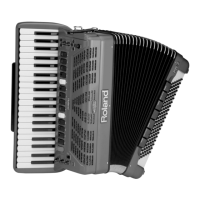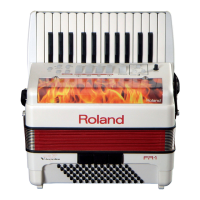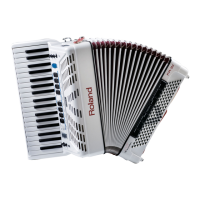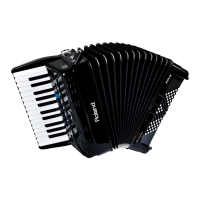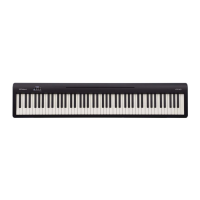21
Performing
Selecting Tones and Playing with the Right Hand
The right hand section can be played using the 37-key keyboard
(piano-type model) or 92 buttons (button-type model) on the
right-hand side.
With the right hand you can play accordion, orchestral and organ
sounds.
1. Press a RIGHT HAND [ACCORDION], [ORCHESTRA],
[ORGAN] button to select the section that you want
to play.
The pressed button lights. The button of the previously selected
section turns off.
In this standard operation you can select one section at a time only.
2. Play the keyboard.
You’ll hear a sound in relation to the section you selected earlier.
MEMO
The FR-4x only produces sound if you move the bellows.
When you don’t move the bellows, you hear nothing at all (as
on an acoustic accordion).
When “Bel Curv (Bellows Curve Type)” (p. 72) is set to “FIX.L
(Fixed Low),” “FIX.M (Fixed Med),” or “FiX.H (Fixed High),”
you don’t need to move the bellows.
3. As necessary, use the [A/B] button to switch the
right-hand register button group between [1]–[7] or
[8]–[14].
4. Use the right registers [1]–[14] to select other
sounds of the selected section.
The selected register name or sound name is briefly displayed.
When you return to the main screen, the number of the selected
right-hand register button is shown using the three digits from the
right in the upper line of the screen.
For details, refer to “Main Screen” (p. 18).
About the right-hand register buttons
When used in conjunction with the [A/B] button, the register
buttons of the FR-4x allow you to directly select 14 sounds.
Since you can also change the orchestral or organ sound that is
assigned to each button, you can choose from more sounds than
the number of actual buttons.
You can choose from 32 sounds for the organ part, and 162
sounds for the orchestral part.
For details on operation, refer to the next section, “Changing the
sounds assigned to the buttons” (p. 21).
Changing the sounds assigned to the buttons
a. In the main screen, use the [
K
] [
J
] buttons to access the screen
that shows the sound numbers of each part.
The illustration above is an example showing the sound
screen for the orchestral part.
For details, refer to “Using the [
K
][
J
] buttons to move
between pages in the main screen” (p. 19).
b. Use the [–] [+] buttons to switch the sound number.
NOTE
You can’t change the reed combination of the accordion part.
How the accordion part’s reed combination is shown
For the accordion part, the lower line of the screen shows the reed combination corresponding to the selected button, as shown below.
Footages 16’ -8’ 8’ +8’ 4’ 2-2/3’ 5-1/3’ ALL
Footage diagram
Corresponding segment
in the screen
Corresponding segment
in the screen
(for Cassotto)
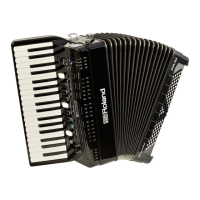
